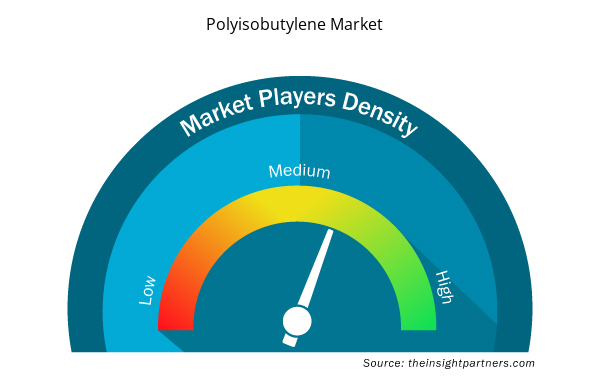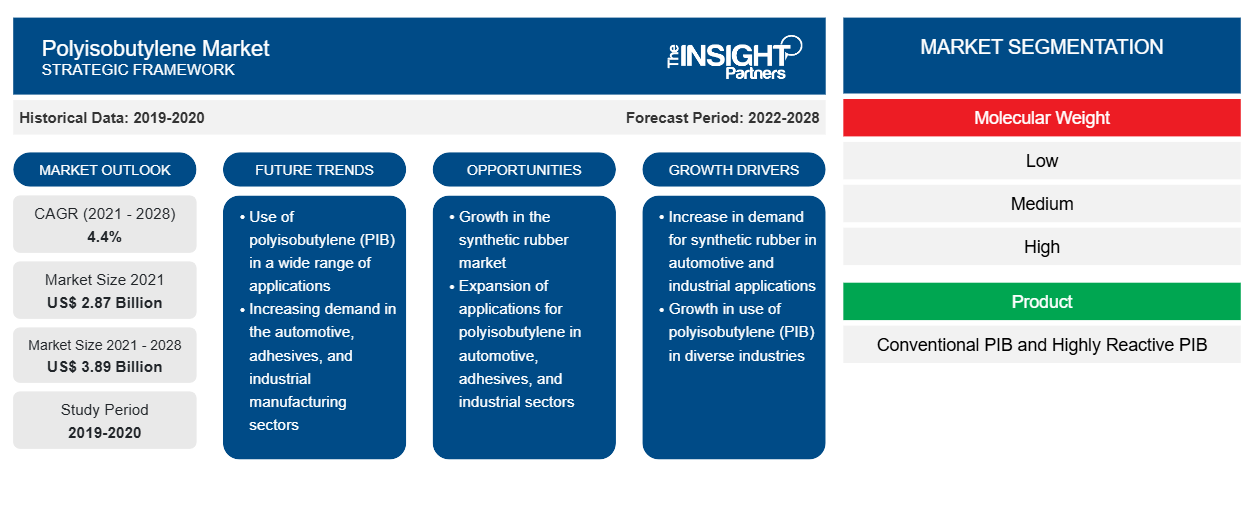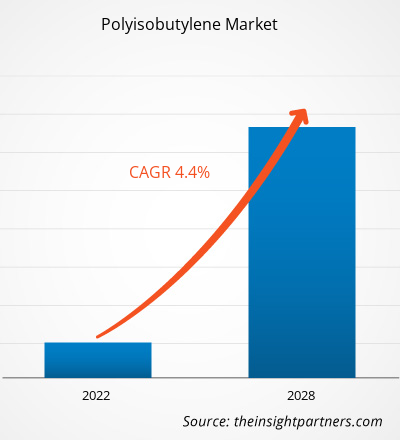[Informe de investigación] El mercado de poliisobutileno se valoró en US$ 2.871,14 millones en 2021 y se proyecta que alcance los US$ 3.891,16 millones en 2028; se espera que crezca a una CAGR del 4,4% entre 2021 y 2028.
El poliisobutileno (PIB) es un elastómero o caucho sintético. Por peso molecular, el mercado está segmentado en bajo, medio y alto. Es un líquido viscoso, versátil, no tóxico y blanco como el agua. El poliisobutileno puede aumentar la adherencia, proporcionar repelencia al agua, mejorar el índice de viscosidad y proporcionar un excelente aislamiento eléctrico.
En 2020, América del Norte tuvo la mayor participación en los ingresos del mercado mundial de poliisobutileno . Las crecientes demandas de diversas aplicaciones, como el transporte, los agroquímicos, la electricidad y los adhesivos, impulsan el crecimiento del mercado en América del Norte. El poliisobutileno se utiliza cada vez más en las industrias del transporte, la alimentación y la construcción, ya que ofrece baja permeabilidad a los gases, excelente resistencia a la tracción, alta resistencia química y mayor rigidez.
Personalice este informe según sus necesidades
Obtendrá personalización en cualquier informe, sin cargo, incluidas partes de este informe o análisis a nivel de país, paquete de datos de Excel, así como también grandes ofertas y descuentos para empresas emergentes y universidades.
- Obtenga las principales tendencias clave del mercado de este informe.Esta muestra GRATUITA incluirá análisis de datos, desde tendencias del mercado hasta estimaciones y pronósticos.
Impacto de la pandemia de COVID-19 en el mercado del poliisobutileno
La pandemia de COVID-19 alteró drásticamente el estado del sector de productos químicos y materiales e impactó negativamente el crecimiento del mercado de poliisobutileno. La industria mundial de productos químicos y materiales es una de las principales industrias que sufre graves interrupciones por la pandemia, como interrupciones de la cadena de suministro, cancelaciones de eventos tecnológicos y cierres de oficinas. Las prohibiciones de viaje globales impuestas por países de Europa, Asia y América del Norte están afectando las oportunidades de colaboración y asociación comerciales. Se prevé que todos estos factores afecten a la industria electrónica y química y de materiales de manera negativa, lo que obstaculiza el crecimiento de varios mercados relacionados con estas industrias. Sin embargo, como las economías planean reactivar sus operaciones, se espera que la demanda de poliisobutileno aumente a nivel mundial. La demanda de poliisobutileno de los sectores de lubricantes industriales y aditivos para lubricantes ha comenzado a aumentar con la reanudación de las actividades comerciales y el levantamiento de las medidas de bloqueo a nivel mundial. Perspectivas del mercado
La industria automotriz impulsará el crecimiento del mercado durante el período de pronóstico
Para la industria automotriz, el desempeño de los motores para realizar sus funciones diarias es importante. La industria automotriz ha sido el mercado clave para varios tipos de aditivos para combustibles durante muchos años. La participación de los automóviles ha sido continuamente mayor que la de otros segmentos del mercado de aditivos para combustibles debido a la falta de alternativas eficientes a los combustibles fósiles y a una economía de clase media en aumento. La importancia relativa de la aviación para los aditivos para combustibles ha aumentado en los últimos años, lo que en última instancia ha aumentado la demanda de poliisobutileno.
Información sobre aplicaciones
Según la aplicación, el mercado mundial de poliisobutileno está segmentado en neumáticos, lubricantes industriales y aditivos para lubricantes, aditivos para combustibles, adhesivos y selladores, entre otros. El segmento de lubricantes industriales y aditivos para lubricantes tuvo la mayor participación del mercado en 2020. El poliisobutileno (PIB) reacciona con anhídrido maleico para formar anhídrido poliisobutenil-succínico (PIBSA), un componente básico para dispersantes en aceites lubricantes y detergentes en combustibles. Su otra variante, la poliisobutileno-succinimida (PIBSI), derivada del poliisobutileno (PIB), actúa como un emulsionante antioxidante en fluidos solubles para trabajar metales y como un componente básico de aditivos para lubricantes. Los PIB también se queman de forma más limpia, lo que los hace ideales para su uso en aceites para motores de dos tiempos y aplicaciones marinas donde los lubricantes están sujetos a gases agresivos de escape de enormes motores diésel.
BASF SE, Braskem SA, Daelim Industrial Petrochemical Division, Ineos AG, Infineum International Limited., Kothari Petrochemicals., Sibur Holding PJSC, Kemat Polybutenes, The Lubrizol Corporation y TPC Group se encuentran entre los actores clave en el mercado global de poliisobutileno. Los actores que operan en el mercado están altamente enfocados en desarrollar ofertas de productos innovadores y de alta calidad para satisfacer los requisitos de los clientes.
Perspectivas regionales del mercado de poliisobutileno
Los analistas de Insight Partners explicaron en detalle las tendencias y los factores regionales que influyen en el mercado de poliisobutileno durante el período de pronóstico. Esta sección también analiza los segmentos y la geografía del mercado de poliisobutileno en América del Norte, Europa, Asia Pacífico, Oriente Medio y África, y América del Sur y Central.

- Obtenga datos regionales específicos para el mercado de poliisobutileno
Alcance del informe de mercado de poliisobutileno
| Atributo del informe | Detalles |
|---|---|
| Tamaño del mercado en 2021 | US$ 2.87 mil millones |
| Tamaño del mercado en 2028 | 3.890 millones de dólares estadounidenses |
| CAGR global (2021-2028) | 4,4% |
| Datos históricos | 2019-2020 |
| Período de pronóstico | 2022-2028 |
| Segmentos cubiertos | Por peso molecular
|
| Regiones y países cubiertos | América del norte
|
| Líderes del mercado y perfiles de empresas clave |
|
Densidad de los actores del mercado de poliisobutileno: comprensión de su impacto en la dinámica empresarial
El mercado del poliisobutileno está creciendo rápidamente, impulsado por la creciente demanda de los usuarios finales debido a factores como la evolución de las preferencias de los consumidores, los avances tecnológicos y una mayor conciencia de los beneficios del producto. A medida que aumenta la demanda, las empresas amplían sus ofertas, innovan para satisfacer las necesidades de los consumidores y aprovechan las tendencias emergentes, lo que impulsa aún más el crecimiento del mercado.
La densidad de actores del mercado se refiere a la distribución de las empresas o firmas que operan dentro de un mercado o industria en particular. Indica cuántos competidores (actores del mercado) están presentes en un espacio de mercado determinado en relación con su tamaño o valor total de mercado.
Las principales empresas que operan en el mercado del poliisobutileno son:
- BASF SE
- Braskem SA
- División Petroquímica Industrial de Daelim
- Ineos AG
- Infineum Internacional Limitada
Descargo de responsabilidad : Las empresas enumeradas anteriormente no están clasificadas en ningún orden particular.

- Obtenga una descripción general de los principales actores clave del mercado de poliisobutileno
Informe Destacado
- Tendencias progresivas de la industria en el mercado de poliisobutileno para ayudar a los actores a desarrollar estrategias efectivas a largo plazo
- Estrategias de crecimiento empresarial adoptadas por los mercados desarrollados y en desarrollo
- Análisis cuantitativo del mercado de poliisobutileno de 2019 a 2028
- Estimación de la demanda mundial de poliisobutileno
- Análisis de las cinco fuerzas de Porter para ilustrar la eficacia de los compradores y proveedores que operan en la industria
- Avances recientes para comprender el escenario competitivo del mercado
- Tendencias y perspectivas del mercado, así como factores que impulsan y restringen el crecimiento del mercado de poliisobutileno
- Asistencia en el proceso de toma de decisiones destacando las estrategias de mercado que sustentan el interés comercial, lo que conduce al crecimiento del mercado.
- El tamaño del mercado de poliisobutileno en varios nodos
- Descripción detallada y segmentación del mercado, así como la dinámica de la industria del poliisobutileno.
- Tamaño del mercado de poliisobutileno en diversas regiones con prometedoras oportunidades de crecimiento
Mercado de poliisobutileno
Por peso molecular
- Bajo
- Medio
- Alto
- Producto
- PIB convencional
- PIB altamente reactivo
Solicitud
- Llantas
- Lubricantes industriales y aditivos para lubricantes
- Aditivos para combustible
- Adhesivos y selladores
- Otros
Industria de uso final
- Industrial
- Alimento
- Otros
Perfiles de empresas
- BASF SE
- Braskem SA
- División Petroquímica Industrial de Daelim
- Ineos AG
- Infineum Internacional Limitada.
- Polibutenos Kemat
- Petroquímica Kothari
- Sociedad Anónima Sibur Holding
- La Corporación Lubrizol
- Grupo TPC
- Análisis histórico (2 años), año base, pronóstico (7 años) con CAGR
- Análisis PEST y FODA
- Tamaño del mercado Valor/volumen: global, regional, nacional
- Industria y panorama competitivo
- Conjunto de datos de Excel


- Greens Powder Market
- Authentication and Brand Protection Market
- Arterial Blood Gas Kits Market
- Biopharmaceutical Contract Manufacturing Market
- Quantitative Structure-Activity Relationship (QSAR) Market
- UV Curing System Market
- Clinical Trial Supplies Market
- Hydrogen Storage Alloys Market
- Enzymatic DNA Synthesis Market
- USB Device Market

Report Coverage
Revenue forecast, Company Analysis, Industry landscape, Growth factors, and Trends

Segment Covered
This text is related
to segments covered.

Regional Scope
North America, Europe, Asia Pacific, Middle East & Africa, South & Central America

Country Scope
This text is related
to country scope.
Preguntas frecuentes
Polyisobutylene (PIB) are also used as substitutes for bright stock owing to their advantages such as better viscosity indices and more oxidative and hydrolytic stability. PIB also burn cleaner, making them ideal for use in two-stroke engines oils and marine applications where lubricants are subjected to harsh blow-by gases from huge diesel engines. PIBs are often used in industrial gear oils and have long been used as thickeners in automotive gear oils. The ubiquitous use of polyisobutylene in industrial gear oils is expected to have a positive influence on the polyisobutylene industry.
The major players operating in the global polyisobutylene market are BASF SE, Braskem SA, Daelim Industrial Petrochemical Division, Ineos AG, Infineum International Limited, Kemat Polybutenes, Kothari Petrochemicals, Sibur Holding PJSC, The Lubrizol Corporation, and TPC Group; among many others.
In 2018, the polyisobutylene market was predominant in North America at the global level. North America region has a well-established automotive and transport industry. The increase in the production of automotive propels the demand for polyisobutylene. Therefore, increased demand for automobiles and infrastructure developments in the US and Canada are expected to fuel the polyisobutylene market during the forecast period.
Trends and growth analysis reports related to Chemicals and Materials : READ MORE..
The List of Companies - Polyisobutylene Market
- BASF SE
- Braskem SA
- Daelim Industrial Petrochemical Division
- Ineos AG
- Infineum International Limited
- Kemat Polybutenes
- Kothari Petrochemicals
- Sibur Holding PJSC
- The Lubrizol Corporation
- TPC Group
The Insight Partners performs research in 4 major stages: Data Collection & Secondary Research, Primary Research, Data Analysis and Data Triangulation & Final Review.
- Data Collection and Secondary Research:
As a market research and consulting firm operating from a decade, we have published and advised several client across the globe. First step for any study will start with an assessment of currently available data and insights from existing reports. Further, historical and current market information is collected from Investor Presentations, Annual Reports, SEC Filings, etc., and other information related to company’s performance and market positioning are gathered from Paid Databases (Factiva, Hoovers, and Reuters) and various other publications available in public domain.
Several associations trade associates, technical forums, institutes, societies and organization are accessed to gain technical as well as market related insights through their publications such as research papers, blogs and press releases related to the studies are referred to get cues about the market. Further, white papers, journals, magazines, and other news articles published in last 3 years are scrutinized and analyzed to understand the current market trends.
- Primary Research:
The primarily interview analysis comprise of data obtained from industry participants interview and answers to survey questions gathered by in-house primary team.
For primary research, interviews are conducted with industry experts/CEOs/Marketing Managers/VPs/Subject Matter Experts from both demand and supply side to get a 360-degree view of the market. The primary team conducts several interviews based on the complexity of the markets to understand the various market trends and dynamics which makes research more credible and precise.
A typical research interview fulfils the following functions:
- Provides first-hand information on the market size, market trends, growth trends, competitive landscape, and outlook
- Validates and strengthens in-house secondary research findings
- Develops the analysis team’s expertise and market understanding
Primary research involves email interactions and telephone interviews for each market, category, segment, and sub-segment across geographies. The participants who typically take part in such a process include, but are not limited to:
- Industry participants: VPs, business development managers, market intelligence managers and national sales managers
- Outside experts: Valuation experts, research analysts and key opinion leaders specializing in the electronics and semiconductor industry.
Below is the breakup of our primary respondents by company, designation, and region:

Once we receive the confirmation from primary research sources or primary respondents, we finalize the base year market estimation and forecast the data as per the macroeconomic and microeconomic factors assessed during data collection.
- Data Analysis:
Once data is validated through both secondary as well as primary respondents, we finalize the market estimations by hypothesis formulation and factor analysis at regional and country level.
- Macro-Economic Factor Analysis:
We analyse macroeconomic indicators such the gross domestic product (GDP), increase in the demand for goods and services across industries, technological advancement, regional economic growth, governmental policies, the influence of COVID-19, PEST analysis, and other aspects. This analysis aids in setting benchmarks for various nations/regions and approximating market splits. Additionally, the general trend of the aforementioned components aid in determining the market's development possibilities.
- Country Level Data:
Various factors that are especially aligned to the country are taken into account to determine the market size for a certain area and country, including the presence of vendors, such as headquarters and offices, the country's GDP, demand patterns, and industry growth. To comprehend the market dynamics for the nation, a number of growth variables, inhibitors, application areas, and current market trends are researched. The aforementioned elements aid in determining the country's overall market's growth potential.
- Company Profile:
The “Table of Contents” is formulated by listing and analyzing more than 25 - 30 companies operating in the market ecosystem across geographies. However, we profile only 10 companies as a standard practice in our syndicate reports. These 10 companies comprise leading, emerging, and regional players. Nonetheless, our analysis is not restricted to the 10 listed companies, we also analyze other companies present in the market to develop a holistic view and understand the prevailing trends. The “Company Profiles” section in the report covers key facts, business description, products & services, financial information, SWOT analysis, and key developments. The financial information presented is extracted from the annual reports and official documents of the publicly listed companies. Upon collecting the information for the sections of respective companies, we verify them via various primary sources and then compile the data in respective company profiles. The company level information helps us in deriving the base number as well as in forecasting the market size.
- Developing Base Number:
Aggregation of sales statistics (2020-2022) and macro-economic factor, and other secondary and primary research insights are utilized to arrive at base number and related market shares for 2022. The data gaps are identified in this step and relevant market data is analyzed, collected from paid primary interviews or databases. On finalizing the base year market size, forecasts are developed on the basis of macro-economic, industry and market growth factors and company level analysis.
- Data Triangulation and Final Review:
The market findings and base year market size calculations are validated from supply as well as demand side. Demand side validations are based on macro-economic factor analysis and benchmarks for respective regions and countries. In case of supply side validations, revenues of major companies are estimated (in case not available) based on industry benchmark, approximate number of employees, product portfolio, and primary interviews revenues are gathered. Further revenue from target product/service segment is assessed to avoid overshooting of market statistics. In case of heavy deviations between supply and demand side values, all thes steps are repeated to achieve synchronization.
We follow an iterative model, wherein we share our research findings with Subject Matter Experts (SME’s) and Key Opinion Leaders (KOLs) until consensus view of the market is not formulated – this model negates any drastic deviation in the opinions of experts. Only validated and universally acceptable research findings are quoted in our reports.
We have important check points that we use to validate our research findings – which we call – data triangulation, where we validate the information, we generate from secondary sources with primary interviews and then we re-validate with our internal data bases and Subject matter experts. This comprehensive model enables us to deliver high quality, reliable data in shortest possible time.


 Obtenga una muestra gratuita de este informe
Obtenga una muestra gratuita de este informe